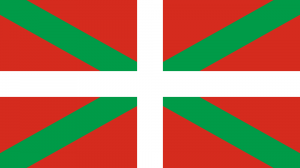Difference between revisions of "Language/Basque/Grammar/Common-Prepositions"
m (Quick edit) |
m (Quick edit) |
||
| Line 111: | Line 111: | ||
* [[Language/Basque/Grammar/0-to-A1-Course|0 to A1 Course]] | * [[Language/Basque/Grammar/0-to-A1-Course|0 to A1 Course]] | ||
* [[Language/Basque/Grammar/Gender|Gender]] | * [[Language/Basque/Grammar/Gender|Gender]] | ||
<span class='maj'></span> | |||
==Sources== | |||
* [https://en.wikipedia.org/wiki/Basque_grammar Basque grammar - Wikipedia] | |||
* [https://polyglotclub.com/wiki/Language/Basque/Grammar/0-to-A1-Course Language/Basque/Grammar/0-to-A1-Course] | |||
* [http://learn101.org/basque_grammar.php Basque Grammar | LEARN101.ORG] | |||
{{Basque-Page-Bottom}} | {{Basque-Page-Bottom}} | ||
Revision as of 21:52, 2 April 2023
Introduction
Welcome to our Basque language course, where you will gain proficiency inBasque and learn to express yourself fluently. In this lesson, we will focus on prepositions, one of the fundamental parts of Basque grammar. Prepositions help us to create relationships between words and express position, direction or place in a sentence. By the end of this lesson, you will learn the most common prepositions in Basque and how to use them correctly.
Prepositions in Basque
Prepositions are almost always placed before a noun, pronoun or gerund, to indicate its relationship to other words in a sentence. In Basque, prepositions are typically combined with definite and indefinite articles, adjectives or pronouns to modify their meanings. Keep in mind that most Basque prepositions are invariable, meaning they do not change with gender or number.
Here is a list of some of the most common prepositions in Basque and their meanings:
| Basque | Pronunciation | English |
|---|---|---|
| aurrean | aou-ren | in front of |
| alboan | al-bo-an | next to |
| aurretik | aou-ren-tik | from ahead |
| artean | ar-te-an | between |
| atzean | at-ze-an | behind |
| bidez | bi-dez | through |
| gainean | ga-i-ne-an | above |
| gainetik | ga-i-ne-tik | from above |
| goian | goi-an | over |
| inguruan | in-gu-ru-an | around |
| kanpoan | kan-po-an | outside |
| korneran | kor-ner-an | in a corner of |
| leku baten | le-kou ba-ten | in a place |
| ondoan | on-do-an | at hand |
| ostean | os-te-an | opposite |
| paretetik | pa-re-te-tik | from the wall |
| pean | pe-an | under |
| gainean | ga-i-ne-an | above |
| sarrera bidez | sar-re-ra bi-dez | through the entrance |
| sendotz bidez | sen-do-tz bi-dez | by means of |
| zaindari bidez | zai-n-da-ri bi-dez | by the guard |
Note that prepositions in Basque are often combined with other words called postpositions, forming a combination of preposition-postposition that carries a more specific meaning. Examples are "gainetik behera" (from top to bottom), "atean sarrera" (entrance door), and "kanpoan atarian" (outside the door).
Preposition Usage
Understanding how to use prepositions in Basque is crucial for mastering the language. Prepositions describe the spatial, temporal, or logical relationship between other elements in a sentence. Here are some essential tips that will help you use these prepositions correctly:
- Use "aurrean" to indicate the position of something that is located in front of you. For example, "Liburuak aurrean daude" (The books are in front of).
- Use "alboan" when something is next to. For example, "Sofa alboan dago" (The sofa is next to).
- Use "artean" to show that something is between two other things. For example, "Etxea bi mendi artean dago" (The house is between two mountains).
- Use "atzean" when the position behind something needs to be described. For example, "Hiria hiriko basoaren atzean dago" (The city is behind the forest of the city).
- Use "goian" to indicate something that is above. For example, "Egurrezko taupadak goian ditu" (The shelf has wooden boards on top).
- Use the preposition "leku baten" when you want to indicate that something is in a place. Use "pean" to describe objects that are below. For example, "On zapiak leku baten daude" (The good shoes are in one place), "Makina pean dago" (The car is below).
- Use "sendotz bidez" to indicate that something is done by means of something else. For example, "Gaztelaniz sendotz bidez hitz egingo dugu" (We will speak in Castilian by means of an interpreter).
- Use "zaindari bidez" to indicate a controlling or monitoring agent. For example, "Bizikleten gida zaindari bidez doa" (The guide goes accompanied by a monitor).
- Use "sarrera bidez" when referring to entering through something, such as a door or gate. For example, "Sarrera bidez sartzeko, gakoa idatzi dezakezu" (You can write the password to enter).
Conclusion
Now that you have a better understanding of the most common prepositions, you can use them to build more complex sentences and express yourself more precisely. By mastering common prepositions, you will gain confidence in your ability to communicate effectively in Basque. Keep practicing and make use of our language resources to reinforce your knowledge of Basque. Remember, the more you practice, the more progress you will make!
Other Lessons
- Possessive Case in Basque
- Prepositions
- Pronouns
- Imperative Tense
- Plurals
- Negation
- Indefinite Articles in Basque
- Definite Articles in Basque
- 0 to A1 Course
- Gender
